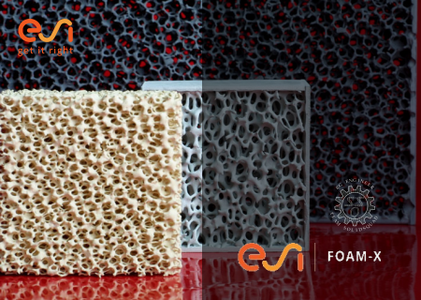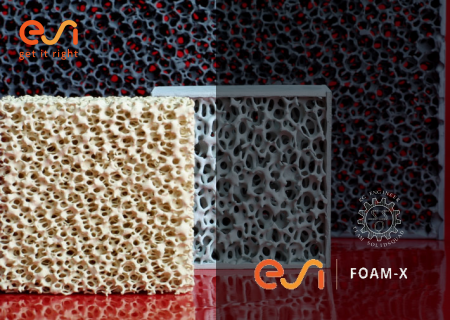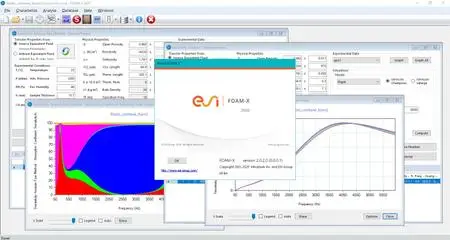ESI FOAM-X 2020.0 | 73.4 mb
The virtual prototyping software provider ESI Group is pleased to announce the availability of FOAM-X 2020.0 is standalone utility for quick characterization of the acoustic properties of open cell porous materials from impedance tube measurements.
FOAM-X Version: 2020 Release Notes - Released: November 2020
General
- User’s Guide and Release Notes are now published using Sphinx documentation generator.
- User’s Guide arrangement has been changed to follow the same flow as software.
- #145868 – Multiple instances of FOAM-X can be launched at the same time.
- Windows behavior has been improved by activating maximize function.
- #150441 – A name can be given to the material exported in Nova or VA One format file.
Advanced Indirect Method – General Porous
- #146544 / #212591 – An export button has been added to export identified results.
Indirect Method – Equivalent Fluid – General Porous
- The window has been updated to be responsive (take into account of the window size). Experimental visualization area has been added.
Inverse Method – Equivalent Fluid – General Porous
- The window has been updated to be responsive (take into account of the window size). Experimental visualization area has been added.
- CPU parallelization based on OpenMP library has been implemented.
- A sample can have a lateral air gap (i.e. sample smaller than the impedance tube). The algorithm takes into account of the size of the sample and the interaction between the air and the sample (see validation example). User must now provide tube and sample diameters.
- A new frame type in the equivalent fluid inverse method module for general porous material. This new frame type is called “Hybrid”.
This frame type translates what happens in the impedance tube when porous material is more or less tightened to tube walls. Below a certain frequency, called transition frequency, the porous material behaves as a rigid material then beyond this transition frequency, it behaves as a limp material. However, this phenomenon does not appear when the material is mounted on a wall. It can only be rigid or limp or elastic.
This hybrid frame is implemented to approximate an elastic behavior with equivalent fluid approach and helps the identification algorithm to find only one set of equivalent fluid parameters for the material which works for the entire frequency range.
To use the hybrid frame, user must enter the porous material bulk density and the transition frequency. This frequency can be identified as the lowest frequency of the elastic resonance in absorption data. Transmission Loss can also help to identify this frequency. More details are given in the theory section.
Inverse Method – Poroelastic – General Porous
- CPU parallelization based on OpenMP library has been implemented.
- #146432 / #212930 – Due to CPU parallelization, initialization part of the poroelastic inverse algorithm has been rewritten. When all parameters are unknown, solution given with FOAM-X 2020 will defer from the one obtained with FOAM-X 2018.
Inverse Method – Equivalent Fluid – Perforated Plate
- CPU parallelization based on OpenMP library has been implemented.
- The window has been updated to be responsive (take into account of the window size). Experimental visualization area has been added.
- #213173 – The “take into account for uncertainties” check box has been removed. It was unused in FOAM-X core (i.e. no available input to the user to enter uncertainty values).
Inverse Method – Equivalent Fluid – Fabrics
- CPU parallelization based on OpenMP library has been implemented.
- The window has been updated to be responsive (take into account of the window size). Experimental visualization area has been added.
- #213173 – The “take into account for uncertainties” check box has been removed. It was unused in FOAM-X core (i.e. no available input to the user to enter uncertainty values).
Simulation and both Sensitivity Analysis Modules
- CPU parallelization based on OpenMP library has been implemented.
- The simulation log is now always displayed.
- The window has been updated to be responsive (take into account of the window size).
- #212108 – A double-click on log entry loads simulation parameters in the module.
- #212108 – The log now registers all user’s parameters (e.g. frequency range, selected experimental data).
- #213332 – In FAST sensitivity module, when transfer properties from inverse poroelastic is selected, all simulated indicator are now activated. However, the computation is based on analytical solver (sliding edge). It does not take into account of boundary conditions such as bonded and lateral air gap.
- A warning on Relative Humidity value in FAST sensitivity module has been added.
Database
- Database password has been modified. Please ask your seller to obtain the new one.
- #212209 – In Add and Update windows, now materials parameters have constraints. For example, a negative Young’s Modulus cannot be entered.
- #212888 – In Add and Update windows, depending on the selected model, mandatory parameters are now highlighted by an asterix *.
- #213059 – The extension file of data export for Excel has been changed to csv with semicolon as separator.
Frame Vibration Tests
- The window has been updated to be responsive (take into account of the window size).
- #147097 – The Frame Vibration Test window is now embedded in the main container. The user can use Characterization or Simulation tabs at the same time when FVT window is opened. A refresh button has been added as in simulation module.
- User’s Guide and Release Notes are now published using Sphinx documentation generator.
- User’s Guide arrangement has been changed to follow the same flow as software.
- #145868 – Multiple instances of FOAM-X can be launched at the same time.
- Windows behavior has been improved by activating maximize function.
- #150441 – A name can be given to the material exported in Nova or VA One format file.
Advanced Indirect Method – General Porous
- #146544 / #212591 – An export button has been added to export identified results.
Indirect Method – Equivalent Fluid – General Porous
- The window has been updated to be responsive (take into account of the window size). Experimental visualization area has been added.
Inverse Method – Equivalent Fluid – General Porous
- The window has been updated to be responsive (take into account of the window size). Experimental visualization area has been added.
- CPU parallelization based on OpenMP library has been implemented.
- A sample can have a lateral air gap (i.e. sample smaller than the impedance tube). The algorithm takes into account of the size of the sample and the interaction between the air and the sample (see validation example). User must now provide tube and sample diameters.
- A new frame type in the equivalent fluid inverse method module for general porous material. This new frame type is called “Hybrid”.
This frame type translates what happens in the impedance tube when porous material is more or less tightened to tube walls. Below a certain frequency, called transition frequency, the porous material behaves as a rigid material then beyond this transition frequency, it behaves as a limp material. However, this phenomenon does not appear when the material is mounted on a wall. It can only be rigid or limp or elastic.
This hybrid frame is implemented to approximate an elastic behavior with equivalent fluid approach and helps the identification algorithm to find only one set of equivalent fluid parameters for the material which works for the entire frequency range.
To use the hybrid frame, user must enter the porous material bulk density and the transition frequency. This frequency can be identified as the lowest frequency of the elastic resonance in absorption data. Transmission Loss can also help to identify this frequency. More details are given in the theory section.
Inverse Method – Poroelastic – General Porous
- CPU parallelization based on OpenMP library has been implemented.
- #146432 / #212930 – Due to CPU parallelization, initialization part of the poroelastic inverse algorithm has been rewritten. When all parameters are unknown, solution given with FOAM-X 2020 will defer from the one obtained with FOAM-X 2018.
Inverse Method – Equivalent Fluid – Perforated Plate
- CPU parallelization based on OpenMP library has been implemented.
- The window has been updated to be responsive (take into account of the window size). Experimental visualization area has been added.
- #213173 – The “take into account for uncertainties” check box has been removed. It was unused in FOAM-X core (i.e. no available input to the user to enter uncertainty values).
Inverse Method – Equivalent Fluid – Fabrics
- CPU parallelization based on OpenMP library has been implemented.
- The window has been updated to be responsive (take into account of the window size). Experimental visualization area has been added.
- #213173 – The “take into account for uncertainties” check box has been removed. It was unused in FOAM-X core (i.e. no available input to the user to enter uncertainty values).
Simulation and both Sensitivity Analysis Modules
- CPU parallelization based on OpenMP library has been implemented.
- The simulation log is now always displayed.
- The window has been updated to be responsive (take into account of the window size).
- #212108 – A double-click on log entry loads simulation parameters in the module.
- #212108 – The log now registers all user’s parameters (e.g. frequency range, selected experimental data).
- #213332 – In FAST sensitivity module, when transfer properties from inverse poroelastic is selected, all simulated indicator are now activated. However, the computation is based on analytical solver (sliding edge). It does not take into account of boundary conditions such as bonded and lateral air gap.
- A warning on Relative Humidity value in FAST sensitivity module has been added.
Database
- Database password has been modified. Please ask your seller to obtain the new one.
- #212209 – In Add and Update windows, now materials parameters have constraints. For example, a negative Young’s Modulus cannot be entered.
- #212888 – In Add and Update windows, depending on the selected model, mandatory parameters are now highlighted by an asterix *.
- #213059 – The extension file of data export for Excel has been changed to csv with semicolon as separator.
Frame Vibration Tests
- The window has been updated to be responsive (take into account of the window size).
- #147097 – The Frame Vibration Test window is now embedded in the main container. The user can use Characterization or Simulation tabs at the same time when FVT window is opened. A refresh button has been added as in simulation module.
#146024 / #146308 / #149911 / #169227 / #212099 / #212365 / #212935 / #213178 / #213416 / #217160 – Some typos in the user’s guide and in FOAM-X have been corrected.
#213026 Typos in Air Properties window has been corrected.
#212599 / #212393 – Minimal size of FOAM-X main window has been increased to ensure that all child windows are well embedded.
Keyboard shortcut for sensitivity analysis module has been change to CTRL+T.
Items in Characterize menu has been sort to group inverse and indirect methods.
#146874 – Unsuccessful simulations were counted in simulation and sensitivity logs which caused broken links in Hide sim menu in graphics windows.
In special case, poroelastic inversion could give a Poisson’s ratio bigger than 0.5.
#146847 – Inconsistent units in example readme files have been corrected.
#146433 – Issue with overridden database backup has been solved.
#146045 – Issue with Nova exportation has been solved.
#212381 – Typo in the csv file exported from Database has been corrected.
#145932 – Description typed in individual graph properties was not saved.
In FVT windows, text in Fr results box is now aligned with the other boxes.
#212246 – In both sensitivity modules, Cavity Porosity and Tube Diameter parameters have been removed from the log because input boxes are not present.
#212583 – In simulation module, the Frequency Step used is FOAM-X core did not match to the value entered by the user.
#212926 – A saved rounded value issue on Tortuosity in Indirect Method – Equivalent Fluid – General Porous has been solved.
#213302 – It was possible to compute with Relative Humidity > 100 % in Sensitivity Analysis and Simulation.
#213302 – An error appeared when the upper constrain value is entered in Atmospheric Pressure and Temperature fields in Sensitivity Analysis, FAST Sensitivity Analysis and Simulation modules. No Error message is now displayed.
#213302 – In FAST Sensitivity module, FOAM-X error message appeared with values in the range [300, 800] in Atmospheric Pressure. No Error message is now displayed.
#213026 Typos in Air Properties window has been corrected.
#212599 / #212393 – Minimal size of FOAM-X main window has been increased to ensure that all child windows are well embedded.
Keyboard shortcut for sensitivity analysis module has been change to CTRL+T.
Items in Characterize menu has been sort to group inverse and indirect methods.
#146874 – Unsuccessful simulations were counted in simulation and sensitivity logs which caused broken links in Hide sim menu in graphics windows.
In special case, poroelastic inversion could give a Poisson’s ratio bigger than 0.5.
#146847 – Inconsistent units in example readme files have been corrected.
#146433 – Issue with overridden database backup has been solved.
#146045 – Issue with Nova exportation has been solved.
#212381 – Typo in the csv file exported from Database has been corrected.
#145932 – Description typed in individual graph properties was not saved.
In FVT windows, text in Fr results box is now aligned with the other boxes.
#212246 – In both sensitivity modules, Cavity Porosity and Tube Diameter parameters have been removed from the log because input boxes are not present.
#212583 – In simulation module, the Frequency Step used is FOAM-X core did not match to the value entered by the user.
#212926 – A saved rounded value issue on Tortuosity in Indirect Method – Equivalent Fluid – General Porous has been solved.
#213302 – It was possible to compute with Relative Humidity > 100 % in Sensitivity Analysis and Simulation.
#213302 – An error appeared when the upper constrain value is entered in Atmospheric Pressure and Temperature fields in Sensitivity Analysis, FAST Sensitivity Analysis and Simulation modules. No Error message is now displayed.
#213302 – In FAST Sensitivity module, FOAM-X error message appeared with values in the range [300, 800] in Atmospheric Pressure. No Error message is now displayed.
FOAM-X is an advanced software used for defining acoustical properties of open-cell porous materials, perforated plates and resistive layers, based on impedance tube measurements following ASTM E1050 or ISO 10534-2, or transmission tube measurement following ASTM E2611. The parameters found with FOAM-X are compatible with poroelastic material modules of commercially available programs such as VA One, and NOVA. All of these modules use the extended Biot’s theory to describe finely porous materials.
ESI Group - Make the Difference with Virtual Prototyping
Founded in 1973, ESI Group envisions a world where Industry commits to bold outcomes, addressing high stakes concerns - environmental impact, safety & comfort for consumers and workers, adaptable and sustainable business models. ESI provides reliable and customized solutions anchored on predictive physics modeling and virtual prototyping expertise to allow industries to make the right decisions at the right time, while managing their complexity. Acting principally in automotive & land transportation, aerospace, defense & naval, energy and heavy industry, ESI is present in more than 20 countries, employs 1200 people around the world and reported 2020 sales of €132.6 million. ESI is headquartered in France and is listed on compartment B of Euronext Paris.
Product: ESI FOAM-X
Version: 2020.0
Supported Architectures: x64
Website Home Page : www.esi-group.com
Languages Supported: english
System Requirements: PC *
Size: 73.4 mb
System Requirements
- Windows 8.1 (64-bit) or 10 (64-bit)
- Intel 64 or AMD64 processor with AVX support
- Minimum of 4 GB RAM
- Ethernet network interface card
- Monitor capable of 32-bit/Hi-color display at 1366x768 resolution
- .Net Frameworks 4.7.1 (packaged in FOAM-X Installer)
- Visual C++ Redistributable Packages 2015 - 2017 - 2019 (packaged in FOAM-X Installer)
- Microsoft SQL Server Express LocalDB v11.0 (packaged in FOAM-X Installer)
- Windows 8.1 (64-bit) or 10 (64-bit)
- Intel 64 or AMD64 processor with AVX support
- Minimum of 4 GB RAM
- Ethernet network interface card
- Monitor capable of 32-bit/Hi-color display at 1366x768 resolution
- .Net Frameworks 4.7.1 (packaged in FOAM-X Installer)
- Visual C++ Redistributable Packages 2015 - 2017 - 2019 (packaged in FOAM-X Installer)
- Microsoft SQL Server Express LocalDB v11.0 (packaged in FOAM-X Installer)
Please visit my blog
Added by 3% of the overall size of the archive of information for the restoration
No mirrors please
Added by 3% of the overall size of the archive of information for the restoration
No mirrors please







